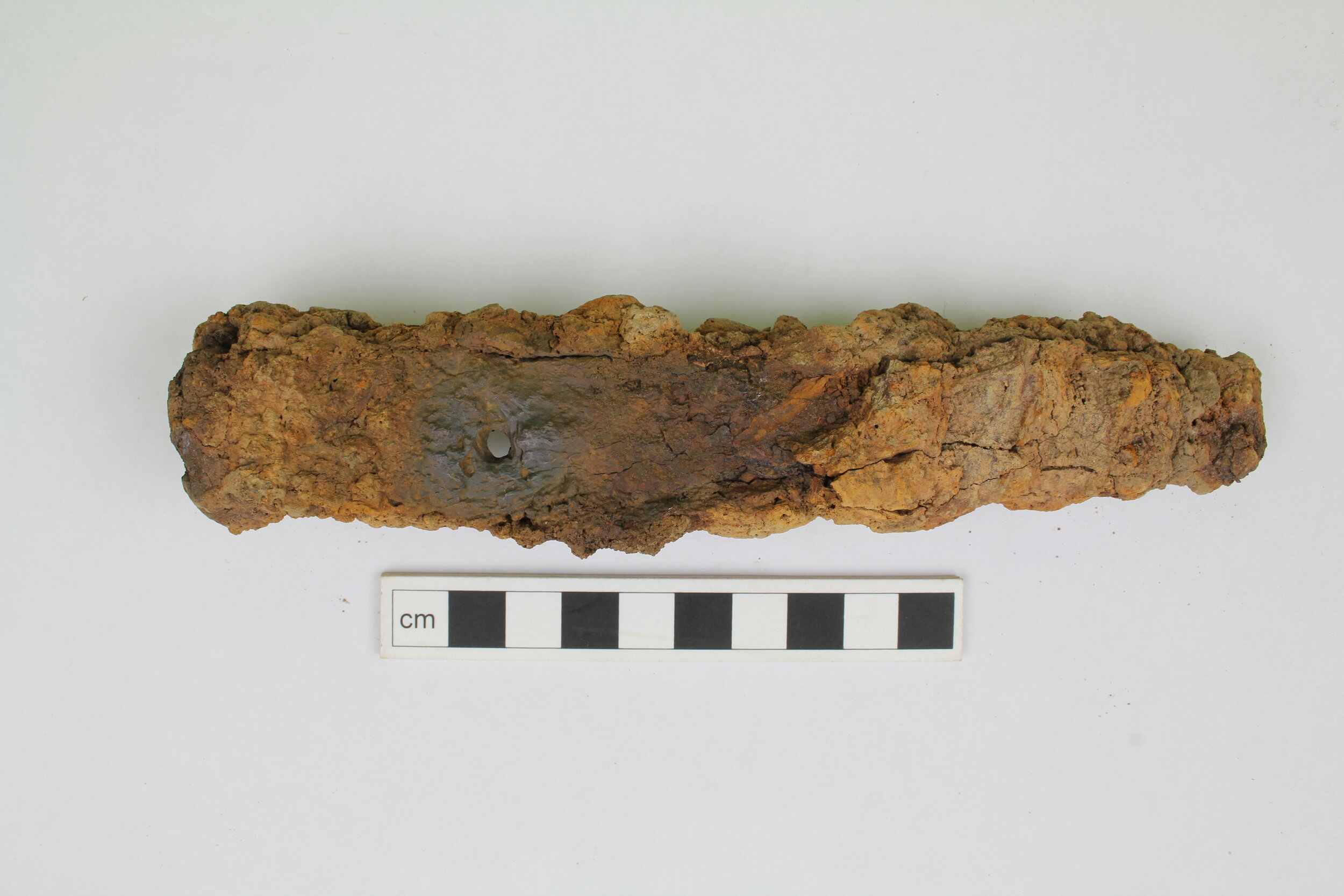
Artefacts from the King’s Seat Hillfort, Dunkeld
Illustration by Chris Mitchell
Just outside Dunkeld is the King’s Seat Hillfort, once home to a powerful Pictish community
The King’s Seat fort sits on a prominent hilltop above the River Tay at Dunkeld, in a commanding position overlooking Strath Tay. Until recently, we knew very little about the site. The fort had never been excavated, so it wasn’t even clear how old it was.
Perth and Kinross Heritage Trust (PKHT) worked in partnership with Dunkeld and Birnam Historical Society to develop a community project to explore the story of the fort. In the autumn of each year from 2017 to 2019, volunteers worked alongside a team of professional archaeologists from AOC Archaeology Group to survey and excavate the site. Find out more about the project at pkht.org.uk.
The artefacts shown below were selected for 3D printing. The resulting models are now on display in Dunkeld Community Archive.
The real archaeological artefacts
3D prints, hand painted to replicate the colours and textures of the originals
The Artefacts from the King’s Seat
A large assemblage of artefacts was recovered during the excavations at the hillfort. These artefacts represent broken and fragmentary pieces of objects made or used by the people who occupied the hillfort around 1,500 years ago during a time known as the early medieval period. The objects found during excavation allow tantalising glimpses into the lives of the people of the hillfort and can help archaeologists understand the types of crafts and activities that were taking place at the site in the past.
You’ll find a brief overview of the artefact assemblage in the gallery below, and further information about the objects in the exhibition beyond that.
Chisel
This intact iron chisel was found on an old ground surface and may be associated with a nearby hearth. This particular example is covered in a thick layer of corrosion, though you can see the original metal surface showing through at the head and central section around the hole, where AOC’s conservators have cleaned back the corrosion.
Chisels like these are used by blacksmiths for cutting hot or cold iron, with cold chisels usually being shorter in length and often handheld, and hot chisels (like this one) usually longer and sometimes with a wire handle attached to help protect the smith from the hot metal they are working.
This chisel is particularly interesting as it has a central hole through the shaft that may once have been threaded with wire loop to form a handle, which is fairly unusual in comparison with other known chisels dating to the same period. The widest part at the top of the chisel is referred to as the head, and you can see how it fans outwards slightly from the shaft, which has been caused by repeated hammer-blows by the smith during use.
The chisel after conservation treatment
3D model of the chisel
Spindle Whorl
This spindle whorl is made from a light brown siltstone and decorated with an incised pattern of repeating horizontal lines within alternating panels. The pattern is mirrored on the opposite side by the same offset pattern.
Spindle whorls were used during textile production to twist raw fibres into thread. They were mounted at the end of a long spindle and spun, with the weighted whorl providing balance and momentum. This particular example has areas of reddish-brown staining on the surface, probably left by the lanolin found in wool.
Traditionally believed to be associated with feminine gender roles, spindle whorls were likely prized personal items that were often intricately decorated and may would have been carried about the person at all times so that the spinning of the fibres could be done whenever it was needed. Spindle whorls may also have been strung and worn as beads when not in use.
This decorated spindle whorl was probably a prized possession
3D model of the spindle whorl
Stone Mould
This is a fragment of a mould that was carved out of a slab of red sandstone, an excellent material for mould making. This particular example was used to cast molten metals into the shape of what appears to be a handled mirror. This example is broken so we can see the hollow for the long narrow ‘handle’ which expands at the broken end into a sub-circular shape, the top of which has been lost.
What type of object was being made is a bit of an enigma, however, as the object produced from this mould would be too thick and too small to be a mirror, and some suggest that perhaps this could be a more unusual form of ingot (as opposed to the more common bar ingots). Others have suggested that it may have formed a blank (also known as a die) which was then beaten into a thin sheet metal object, such as a vessel or a lamp.
We do not know exactly what object was produced from this mould as no metal objects survive from the early medieval period that closely match its form or shape. As it stands, the function of this stone remains a bit of a mystery, although stones carved with similar shapes have been found on other sites in contexts where metalworking was taking place.
This stone mould may have been used for making ingots
3D model of the stone mould
Ceramic Mould
This is part of a mould made from red fired clay that was used to cast objects out of copper alloy. This is one half of a mould that would have had a mirror image of what you see here on the other side. If you look closely you can see the outline of a circular ring with a triangular portion next to it. This triangular portion is the valve into which the molten metal was poured, which would have filled the circular portion, creating a small ring or possibly a brooch hoop. Lots of these types of clay moulds were found on King’s Seat, but because the clay is so fragile, hardly any have survived that show recognisable forms, which is important in knowing what types of objects were being cast. This type of casting is known to have taken place on other similar high status sites across Scotland, such as at the Brough of Birsay in Orkney, the Mote of Mark in Dumfries and Galloway, at Dunadd in Argyll and Bute, and at Rhynie in Aberdeenshire.
Fragment of a mould used to make copper alloy objects, perhaps jewellery
3D model of the ceramic mould
E-ware handle
This is a handle fragment from a small ceramic jug. This type of ceramic is known as E-ware, which generally dates from the later 6th and 7th centuries AD, and is recognisable by its white gritty fabric. E-ware is thought to originate in the Saintes region of south-west France, and was imported to Scotland acting as a container for exotic goods such as nuts, fruits, spices, wine, purple dyes, and other luxury items.
Jugs such as the one this handle is from are rare amongst E-ware assemblages, and this one is even small in comparison and must have come from a very small jug. Only two other small jugs have been found in Britain, one from the Mote of Mark, and another from Whithorn, both of which are in Dumfries and Galloway.
In addition to the small jug, other E-ware vessel forms such as a bowl and a jar were also identified at King’s Seat. The discovery of more than one type of E-ware vessel at a single site is quite unusual, and suggests that King’s Seat may have a royal association with links to other sites such as Dunadd in Argyll and Bute, and may have been involved in the importation and redistribution of luxury goods.
Part of the handle of a small jug, imported from the continent
3D model of the jug handle
Stone Sling Shot
Some of the many rounded pebbles discovered during the excavations
The exhibition includes a little pile of innocuous-looking pebbles. Over 500 small ovoid pebbles were discovered during the excavations. Although the pebbles have not been deliberately shaped and do not bear any signs of use, they are likely to have been brought up to the fort from a nearby riverbed rather than being on the hill naturally. The similarity of size, colour and shape suggest that they were carefully chosen. Could these be collections of shot, to be used during target practice, or while defending the site from unwelcome visitors?
What happens after excavation?
After the excavation, all of the artefacts recovered were taken back to AOC’s laboratory for analysis and recording. During the post-excavation process, artefact specialists examined each object with the aim of finding clues about how the object might have been made or used, what period of prehistory or history the object might date to and what the object can tell us about the lives of people in the past. Once the analysis is complete, all the information about the excavations will be brought together in a book which will present the story of the hillfort. The artefacts will be reported to the Scottish Treasure Trove Unit for allocation to a museum collection.
The artefact specialists involved in the King’s Seat project selected some of their favourite objects from the collection, to reproduce for exhibition as 3D laser printed models. These models were produced by AOC on behalf of PKHT, who have gifted them to Dunkeld Community Archive for display, and to form part of their collections.
Modelling the Past
Digital recording has been used in archaeology for a while. Digital models, like the one shown below, can help us piece together fragmentary artefacts, and provide a way for audiences to explore artefacts from afar. 3D printing provides a fascinating new opportunity for engagement with the past.
Archaeological artefacts can provide a tangible link to people who lived centuries, or even millennia, before us. However, most are too fragile to be handled freely and are viewed behind glass or stored in archives. 3D prints of artefacts, made from highly accurate 3D models created from data gathered through digital recording methods, can provide an opportunity for a tactile experience, allowing a more personal connection. 3D printing technology is also making heritage more inclusive and accessible for people with visual impairments – dedicated handling kits are gaining more popularity across cultural institutions in the UK and beyond.
Digital models provide an opportunity to take a closer look
3D prints are made using a single colour
Detail is added by hand, to recreate the object’s appearance























